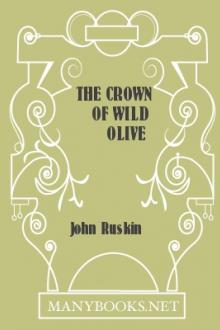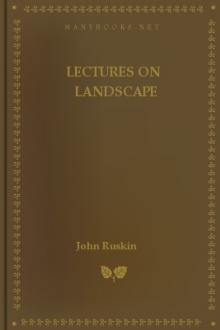The Crown of Wild Olive by John Ruskin (a court of thorns and roses ebook free .TXT) 📕

- Author: John Ruskin
- Performer: -
Book online «The Crown of Wild Olive by John Ruskin (a court of thorns and roses ebook free .TXT) 📕». Author John Ruskin
158. Thirdly. Stone-sculpture divides itself into three schools: one in very hard material; one in very soft, and one in that of centrally useful consistence.
A. The virtue of work in hard material is the expression of form in shallow relief, or in broad contours; deep cutting in hard material is inadmissible, and the art, at once pompous and trivial, of gem engraving, has been in the last degree destructive of the honour and service of sculpture.
B. The virtue of work in soft material is deep cutting, with studiously graceful disposition of the masses of light and shade. The greater number of flamboyant churches of France are cut out of an adhesive chalk; and the fantasy of their latest decoration was, in great part, induced by the facility of obtaining contrast of black space, undercut, with white tracery easily left in sweeping and interwoven rods—the lavish use of wood in domestic architecture materially increasing the habit of delight in branched complexity of line. These points, however, I must reserve for illustration in my lectures on architecture. To-day, I shall limit myself to the illustration of elementary sculptural structure in the best material;—that is to say, in crystalline marble, neither soft enough to encourage the caprice of the workman, nor hard enough to resist his will.
159. C. By the true "Providence" of Nature, the rock which is thus submissive has been in some places stained with the fairest colours, and in others blanched into the fairest absence of colour, that can be found to give harmony to inlaying, or dignity to form. The possession by the Greeks of their λευκος λιθος was indeed the first circumstance regulating the development of their art; it enabled them at once to express their passion for light by executing the faces, hands, and feet of their dark wooden statues in white marble, so that what we look upon only with pleasure for fineness of texture was to them an imitation of the luminous body of the deity shining from behind its dark robes; and ivory afterwards is employed in their best statues for its yet more soft and flesh-like brightness, receptive also of the most delicate colour—(therefore to this day the favourite ground of miniature painters). In like manner, the existence of quarries of peach-coloured marble within twelve miles of Verona, and of white marble and green serpentine between Pisa and Genoa, defined the manner both of sculpture and architecture for all the Gothic buildings of Italy. No subtlety of education could have formed a high school of art without these materials.
160. Next to the colour, the fineness of substance which will take a perfectly sharp edge, is essential; and this not merely to admit fine delineation in the sculpture itself, but to secure a delightful precision in placing the blocks of which it is composed. For the possession of too fine marble, as far as regards the work itself, is a temptation instead of an advantage to an inferior sculptor; and the abuse of the facility of undercutting, especially of undercutting so as to leave profiles defined by an edge against shadow, is one of the chief causes of decline of style in such encrusted bas-reliefs as those of the Certosa of Pavia and its contemporary monuments. But no undue temptation ever exists as to the fineness of block fitting; nothing contributes to give so pure and healthy a tone to sculpture as the attention of the builder to the jointing of his stones; and his having both the power to make them fit so perfectly as not to admit of the slightest portion of cement showing externally, and the skill to insure, if needful, and to suggest always, their stability in cementless construction. Plate X. represents a piece of entirely fine Lombardic building, the central portion of the arch in the Duomo of Verona, which corresponds to that of the porch of San Zenone, represented in Plate I. In both these pieces of building, the only line that traces the architrave round the arch, is that of the masonry joint; yet this line is drawn with extremest subtlety, with intention of delighting the eye by its relation of varied curvature to the arch itself; and it is just as much considered as the finest pen-line of a Raphael drawing. Every joint of the stone is used, in like manner, as a thin black line, which the slightest sign of cement would spoil like a blot. And so proud is the builder of his fine jointing, and so fearless of any distortion or strain spoiling the adjustment afterwards, that in one place he runs his joint quite gratuitously through a bas-relief, and gives the keystone its only sign of pre-eminence by the minute inlaying of the head of the Lamb, into the stone of the course above.
161. Proceeding from this fine jointing to fine draughtsmanship, you have, in the very outset and earliest stage of sculpture, your flat stone surface given you as a sheet of white paper, on which you are required to produce the utmost effect you can with the simplest means, cutting away as little of the stone as may be, to save both time and trouble; and, above all, leaving the block itself, when shaped, as solid as you can, that its surface may better resist weather, and the carved parts be as much protected as possible by the masses left around them.
162. The first thing to be done is clearly to trace the outline of subject with an incision approximating in section to that of the furrow of a plough, only more equal-sided. A fine sculptor strikes it, as his chisel leans, freely, on marble; an Egyptian, in hard rock, cuts it sharp, as in cuneiform inscriptions. In any case, you have a result somewhat like the upper figure, Plate XI., in which I show you the most elementary indication of form possible, by cutting the outline of the typical archaic Greek head with an incision like that of a Greek triglyph, only not so precise in edge or slope, as it is to be modified afterwards.
163. Now, the simplest thing we can do next, is to round off the flat surface within the incision, and put what form we can get into the feebler projection of it thus obtained. The Egyptians do this, often with exquisite skill, and then, as I showed you in a former lecture, colour the whole—using the incision as an outline. Such a method of treatment is capable of good service in representing, at little cost of pains, subjects in distant effect, and common, or merely picturesque, subjects even near. To show you what it is capable of, and what coloured sculpture would be in its rudest type, I have prepared the coloured relief of the John Dory[129] as a natural history drawing for distant effect. You know, also, that I meant him to be ugly—as ugly as any creature can well be. In time, I hope to show you prettier things—peacocks and kingfishers,—butterflies and flowers, on grounds of gold, and the like, as they were in Byzantine work. I shall expect you, in right use of your æsthetic faculties, to like those better than what I show you to-day. But it is now a question of method only; and if you will look, after the lecture, first at the mere white relief, and then see how much may be gained by a few dashes of colour, such as a practised workman could lay in a quarter of an hour,—the whole forming, if well done, almost a deceptive image—you will, at least, have the range of power in Egyptian sculpture clearly expressed to you.
164. But for fine sculpture, we must advance by far other methods. If we carve the subject with real delicacy, the cast shadow of the incision will interfere with its outline, so that, for representation of beautiful things, you must clear away the ground about it, at all events for a little distance. As the law of work is to use the least pains possible, you clear it only just as far back as you need, and then for the sake of order and finish, you give the space a geometrical outline. By taking, in this case, the simplest I can,—a circle,—I can clear the head with little labor in the removal of surface round it; (see the lower figure in Plate XI.)
165. Now, these are the first terms of all well-constructed bas-relief. The mass you have to treat consists of a piece of stone, which, however you afterwards carve it, can but, at its most projecting point, reach the level of the external plane surface out of which it was mapped, and defined by a depression round it; that depression being at first a mere trench, then a moat of certain width, of which the outer sloping bank is in contact, as a limiting geometrical line, with the laterally salient portions of sculpture. This, I repeat, is the primal construction of good bas-relief, implying, first, perfect protection to its surface from any transverse blow, and a geometrically limited space to be occupied by the design, into which it shall pleasantly (and as you shall ultimately see, ingeniously,) contract itself: implying, secondly, a determined depth of projection, which it shall rarely reach, and never exceed: and implying, finally, the production of the whole piece with the least possible labor of chisel and loss of stone.
166. And these, which are the first, are very nearly the last constructive laws of sculpture. You will be surprised to find how much they include, and how much of minor propriety in treatment their observance involves.
In a very interesting essay on the architecture of the Parthenon, by the professor of architecture of the Ecole Polytechnique, M. Emile Boutmy, you will find it noticed that the Greeks do not usually weaken, by carving, the constructive masses of their building; but put their chief sculpture in the empty spaces between the triglyphs, or beneath the roof. This is true; but in so doing, they merely build their panel instead of carving it; they accept no less than the Goths, the laws of recess and limitation, as being vital to the safety and dignity of their design; and their noblest recumbent statues are, constructively, the fillings of the acute extremity of a panel in the form of an obtusely summitted triangle.
167. In gradual descent from that severest type, you will find that an immense quantity of sculpture of all times and styles may be generally embraced under the notion of a mass hewn out of, or, at least, placed in, a panel or recess, deepening, it may be, into a niche; the sculpture being always designed with reference to its position in such recess; and, therefore, to the effect of the building out of which the recess is hewn.
But, for the sake of simplifying our inquiry, I will at first suppose no surrounding protective ledge to exist, and that the area of stone we have to deal with is simply a flat slab, extant from a flat surface depressed all round it.
168. A flat slab, observe. The flatness of surface is essential to the problem of bas-relief. The lateral limit of the panel may, or may not, be required; but the vertical limit of surface must be expressed; and the art of bas-relief is to give the effect of true form on that condition. For observe, if nothing more were needed than





Comments (0)